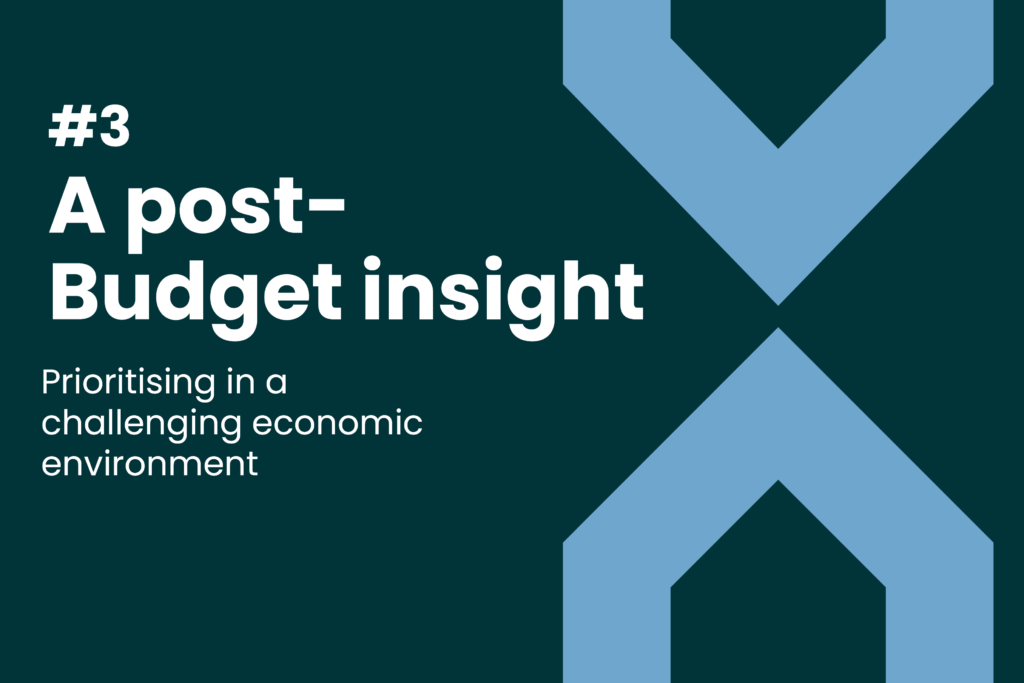
A series of insights from friends of the firm and long-standing leaders across the Built Environment
In the third of our series, in discussion with a group of industry leaders looking at topics and themes of importance in the Built Environment, we are focusing on the ongoing challenge of finance. As we emerge post-budget in the UK, we will consider some of the areas they believe should be prioritised, and how with the correct planning and approach these can enhance living and working environments across the country.
An undeniable truth (or two)
We need more homes in the UK. No politician would or could deny that. If it was just a case of building those, it might seem simple enough. But in a particularly challenging backdrop of constrained finances, skills shortages, and identifying areas of greatest geographic need, the complexity becomes evident.
However, it is a challenge that the Government appears committed to addressing as a priority, and an area of policy focus that our commentators welcome.
But creating a sustainable ecosystem across the built environment extends well beyond building more homes. It means supporting, regenerating and investing in community-based living and working to ensure a positive and sustainable future in regions right across the UK.
Financial planning must be a priority
In 2024 the UK is one of the world’s largest economies and it is really not good enough that we have so many people living in poverty.
The commitment to building more homes that are affordable and appealing is a key goal for the Government and has in some part been evidenced by the announcement of a new investment vehicle that aims to build 3,000 low-carbon and affordable rental homes across England.
While at early stages, this is welcome news to many, and it is hoped with a renewed focus on the rent settlement post 2026 – that there will be a greater level of certainty for Housing Associations to set in place longer terms planning. A short-term approach will not work when significant investments must be made to both build new houses, but also to ensure that existing stock is upgraded and fundamentally safe.
When the strategic plan is fully financed, we can’t just squeeze things in – it just can’t work like that anymore. We need long term investment view and a commitment to priorities otherwise something falls over and we can’t take that risk.
The emphasis on devolution in the regions also provides that opportunity to gain more control, according to one commentator, and replace short term targets, which will in turn make planning and investing more feasible. But all our leaders do recognise that the economy is fragile, and while this budget has been positioned as a way to stimulate economic growth, there is still a way to go and it will take time to see it bear fruit and those working in the sector are acutely aware of this.
In the private rented sector there remain strong regional disparities and static supply, but it is hoped that with no changes in capital gains tax (CGT) for landlords in this budget, it is believed that this will keep a greater supply of property in the rented sector and hopefully limit rental rises in already struggle areas like London and the South East, which adversely affects those on the lowest incomes.
Making energy efficiency attractive
There is pressure to achieve net zero and deliver lower carbon development and upgrade in the built environment, but that comes with significant financial commitment.
It needs to be done in a way that makes these properties suitable for contemporary occupation in a sustainable way.
There was clear consensus on the need to make energy improvements and performance ratings a much greater point of attraction – to emphasis the longer-term cost benefits of owning a more efficient house or office space – not just an upfront immediate cost when building, upgrading or retrofitting.
One leader did caution against knocking down and building new, or defaulting to expansion into green space. It was noted that in many thriving economies the best hope comes from retaining old streetscapes – maintaining city and community design that has existed and worked for people for decades, if not centuries.
These investments in achieving net zero are substantial and are becoming increasingly mandated. And this comes in addition to the absolutely essential safety upgrades needed in parts of the housing sector. The finance to deliver this is being earmarked, but it has to come with a more open approach to funding, whilst also keeping up with customer expectations.
Open to doing things differently
As an industry the need to be more open to different financial models and ways of operating was clear, with safety and productivity as key drivers.
However, the price of construction is not going down and therefore land value needs to be considered more acutely with far greater discussion together from landlords, institutional investors and the public sector.
The suggestion of shifting Housing Associations away from development and land ownership to running and managing more properties was discussed. But it was clear from one commentator that relying on above inflationary event rises to make business plans stack up is not going to work. A “properly calculated and resourced development grant regime” was mooted, and one that potentially should be considered in the wider round of planning for the future.
This is an industry facing considerable challenge, one which is recognised and prioritised for action by Government, but there is welcome optimism and commitment evident. As one leader put it: “We have a demonstrable ability to adapt to change and find a way to keep doing things. We will find a way.”
Adviser view
As trusted advisers in this space we are all too aware of the financial pressures our leaders face, almost at an unprecedented scale for the expectations laid up on them. But what we are seeing is an ability to think differently and recognise that long-standing approaches need to be reconsidered. There are necessities which must be met in the more immediate future and this requires consensus and collaboration, to achieve common goals for a longer term future. We see leaders who recognise both this strategic position but are adaptable and make often challenging decisions about what is required in an agile and innovative way, whilst recognising the shift to an increasingly higher level of customer expectation and service. The road ahead is not an easy one, but the eventual destination promises a better future for all.
Committed to Leadership Excellence in the Built Environment
Our Built Environment practice group is committed to finding and supporting excellent and authentic leaders across infrastructure, local and regional development, housing and transport to deliver tangibly positive benefits for existing, emerging and new communities across the UK. To find out more about how we can support your organisation’s leadership development and appointments, please get in touch with Vidhu Sood-Nicholls or Hannah Scarisbrick in our team.

All chapters:
Chapter 2 – Industry obstacles and how we can challenge them together
Chapter 3 – A post-budget insight
Chapter 4 – Priorities for the next decade

